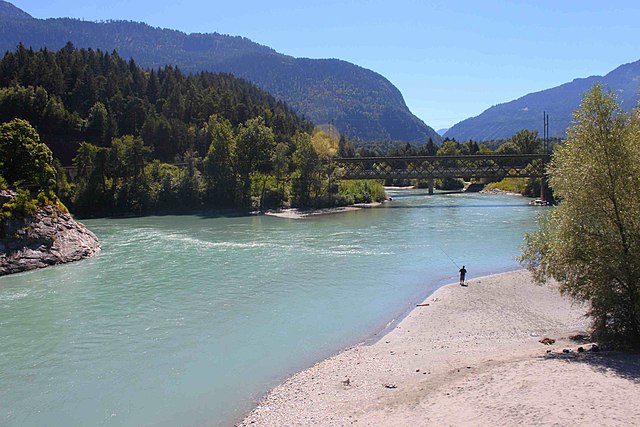The Alpine Rhine Valley is a glacial alpine valley, formed by the Alpine Rhine, the part of the River Rhine between the confluence of the Anterior Rhine and Posterior Rhine at Reichenau and Lake Constance. It covers three countries, with sections of the river demarcating the borders between Austria and Switzerland and between Liechtenstein and Switzerland. The full length of the Alpine Rhine is 93.5 km.
The end of the Grisonian Rhine Valley where the Alpine Rhine turns around the Fläscher Berg to the north, east of Sargans. In front: Bad Ragaz on the left and Maienfeld on the right.
The St. Gall Rhine Valley, on the right, and the Liechtenstein Rhine Valley, on the left of the Alpine Rhine, as seen from the Stauberen (1,745 m (5,725 ft))
The mouth of the Alpine Rhine and the "Rhine Valley" looking south
The Old Rhine (Alter Rhein) in Höchst
The Rhine is one of the major European rivers. The river begins in the Swiss canton of Graubünden in the southeastern Swiss Alps. It forms part of the Swiss-Liechtenstein, Swiss-Austrian, and Swiss-German borders. After that the Rhine defines much of the Franco-German border, after which it flows in a mostly northerly direction through the German Rhineland. Finally in Germany, the Rhine turns into a predominantly westerly direction and flows into the Netherlands where it eventually empties into the North Sea. It drains an area of 9,973 km2 and its name derives from the Celtic Rēnos. There are also two German states named after the river, North Rhine-Westphalia and Rhineland-Palatinate.
The Rhine in Basel, Switzerland
Lake Toma seen from the Rhine's upstream end
The confluence of the Anterior Rhine to the lower left and the Posterior Rhine in the background forms the Alpine Rhine (to the left) next to Reichenau.
The Rhine between Sargans in Switzerland (left) and Balzers in Liechtenstein (right) with the Gonzen (1,829 m (6,001 ft), left), the Girrenspitz (2,099 m (6,886 ft)) in the back, and the Maziferchopf (855 m (2,805 ft)) to the right








